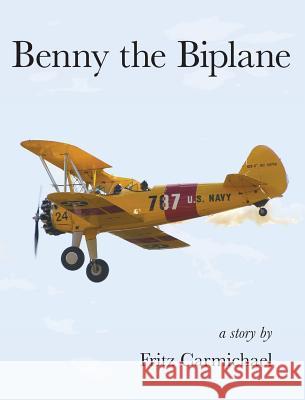Benny the Biplane » książka
Benny the Biplane
ISBN-13: 9781945033117 / Angielski / Twarda / 2016 / 28 str.
Benny the Biplane
ISBN-13: 9781945033117 / Angielski / Twarda / 2016 / 28 str.
(netto: 82,03 VAT: 5%)
Najniższa cena z 30 dni: 86,36
ok. 16-18 dni roboczych
Bez gwarancji dostawy przed świętami
Darmowa dostawa!
BENNY THE BIPLANE is a beginning reader for children ages 4-8 with decidedly educational and historical leanings. The text is that of a traditional children's picture book for very young readers, and it weighs in at just 308 words in 24 pages. It uses repetition of simple time elements and clauses, mostly monosyllabic words (monosyllabic being one of the most ironic words in the English language), and syntactically is short and easy to read. It covers concepts such as jobs, joblessness, sadness, hope, and success, with both a resolution and an ending that reinforce the concept that even when the outlook appears dim, the future may hold better opportunities than the one that was lost. It is unlike other children's books because It incorporates historical black-and-white photographs of actual biplanes, including a list of illustrations in the back matter that indicates the model of biplane (and some other planes as well), approximate shooting date, and location (if available) for each photograph. It also has a drawing of a mouse flying a cartoon biplane. This additional detail (other than the mouse, probably) widens the age range of the book's audience, provides additional information for those readers who are interested, and creates additional learning and discussion opportunities for children, their parents, librarians, and educators. For flying nuts (we're not sure that's the correct term, but we're running with it anyway), the photographs may bring back memories of the rich heritage of biplanes in the United States and Europe. For young readers, and even their parents, the initial reaction may be, "Where are the colors?" But please give it a chance. It's a great story, and the illustrations did not drive the story--the other way around. Unfortunately, though some color illustrations could be used, it would detract from the style and consistency of the work. Other books in the series will incorporate color illustrations depending on the subject matter and appropriate style considerations. From an educational standpoint, the book provides excellent reading practice for children who are still mastering the fundamentals of simple sentence structure and common word forms. It may be appealing to young boys who have only a modest interest in books and reading, though we have found that little girls love the book as much as or more than boys do. Children as young as three years old have enjoyed having BENNY THE BIPLANE read to them. As a picture book, it's relatively short, so it's a great, easy read on those nights when a longer book won't quite fit the bill. We hope you love it
BENNY THE BIPLANE is a beginning reader for children ages 4-8 with decidedly educational and historical leanings. The text is that of a traditional children's picture book for very young readers, and it weighs in at just 308 words in 24 pages. It uses repetition of simple time elements and clauses, mostly monosyllabic words (monosyllabic being one of the most ironic words in the English language), and syntactically is short and easy to read. It covers concepts such as jobs, joblessness, sadness, hope, and success, with both a resolution and an ending that reinforce the concept that even when the outlook appears dim, the future may hold better opportunities than the one that was lost. It is unlike other children's books because It incorporates historical black-and-white photographs of actual biplanes, including a list of illustrations in the back matter that indicates the model of biplane (and some other planes as well), approximate shooting date, and location (if available) for each photograph. It also has a drawing of a mouse flying a cartoon biplane. This additional detail (other than the mouse, probably) widens the age range of the book's audience, provides additional information for those readers who are interested, and creates additional learning and discussion opportunities for children, their parents, librarians, and educators.For flying nuts (we're not sure that's the correct term, but we're running with it anyway), the photographs may bring back memories of the rich heritage of biplanes in the United States and Europe. For young readers, and even their parents, the initial reaction may be, "Where are the colors?" But please give it a chance. It's a great story, and the illustrations did not drive the story—the other way around. Unfortunately, though some color illustrations could be used, it would detract from the style and consistency of the work. Other books in the series will incorporate color illustrations depending on the subject matter and appropriate style considerations. From an educational standpoint, the book provides excellent reading practice for children who are still mastering the fundamentals of simple sentence structure and common word forms. It may be appealing to young boys who have only a modest interest in books and reading, though we have found that little girls love the book as much as or more than boys do. Children as young as three years old have enjoyed having BENNY THE BIPLANE read to them. As a picture book, it's relatively short, so it's a great, easy read on those nights when a longer book won't quite fit the bill. We hope you love it!











